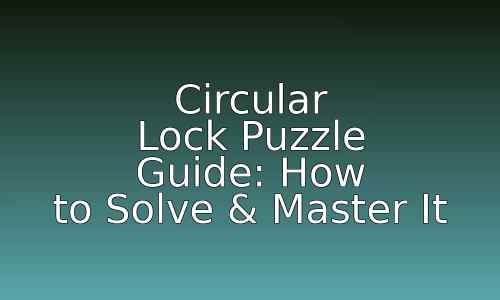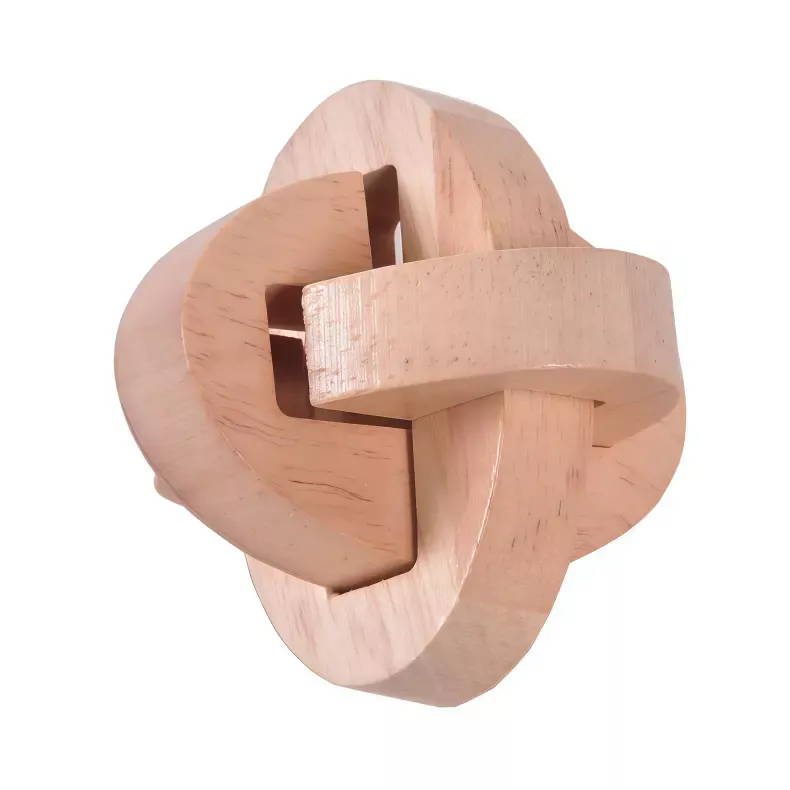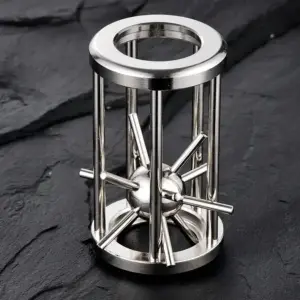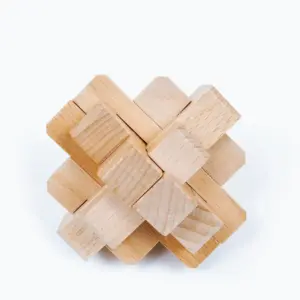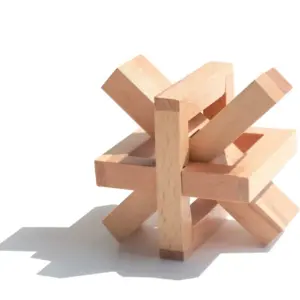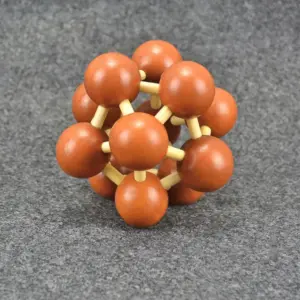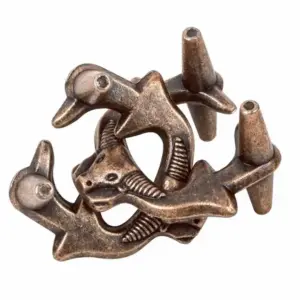I’ve been collecting and reviewing wooden puzzles for over a decade, and the Circular Lock consistently surprises me. Not because it’s the hardest puzzle out there—it’s not. But because it strikes that rare balance between accessibility and genuine challenge. You can hand it to a complete beginner and watch them struggle for 20 minutes, or give it to a seasoned puzzle solver who’ll crack it in five. Either way, everyone walks away impressed.
The Circular Lock is a three-piece interlocking wooden puzzle that looks deceptively simple. One solid ring, two C-shaped notched pieces. That’s it. But the way these pieces interact—the curves, the notches, the precise tolerances—makes this puzzle feel like a magic trick the first time you solve it. And unlike those plastic fidget toys that end up in landfills, this is a piece of craftsmanship you’ll keep on your desk for years.
If you’ve seen the [YouTube solution video], you know how satisfying that final “click” sounds when everything locks into place. Let’s break down exactly how this puzzle works, why it’s designed the way it is, and how you can master it.
Understanding the Three Pieces: Anatomy of the Circular Lock
Before you can solve any puzzle, you need to understand what you’re working with. The Circular Lock consists of three precision-cut wooden components, each serving a specific mechanical function.
The Solid Ring Piece
This is your anchor—the foundation of the entire puzzle. It’s a complete, unbroken elliptical ring with smooth, rounded edges and a rectangular cross-section. Think of it as the “O” in a word puzzle: stable, unchanging, and essential. The ring’s job is to serve as the core framework through which the other two pieces must thread. Without it, you just have two loose C-shapes with nowhere to go.
The Two C-Shaped Notched Pieces
These are mirror images of each other—perfectly symmetrical twins. Each one looks like someone took a circular ring and sliced out a segment, leaving a clean gap with flat, parallel edges. The notches aren’t just decorative; they’re the puzzle’s secret. These gaps allow the pieces to slide past each other and the solid ring in very specific ways. The outer and inner curves are smooth arcs, and the rectangular cross-section matches the solid ring perfectly.
Here’s the clever part: the two C-pieces work together to “trap” the solid ring in the middle. When assembled correctly, they create a locked structure that feels impossible to separate unless you know the trick.
How to Disassemble the Circular Lock (Step-by-Step)
Disassembly is usually easier than reassembly, but it’s still worth understanding the logic. Here’s how to take apart the Circular Lock without forcing anything.
Step 1: Identify the Key Components
Hold the assembled puzzle and rotate it slowly. You’ll notice two pieces have visible notches (the C-shapes) and one is a complete ring. Your goal is to separate these without brute force.
Step 2: Locate the Entry Point
Turn the puzzle until one of the C-shaped pieces (let’s call it “Piece A”) has its notch facing you. This is your breakthrough angle.
Step 3: Slide Piece A Outward
Using your thumb and forefinger, grip the ends of Piece A and gently slide it along its natural curve, moving it outward. Keep the other two pieces stable with your other hand. Don’t yank—let the piece glide along the contour of the solid ring.
Step 4: Remove Piece A
Once Piece A has slid far enough, it’ll pop free from the solid ring. Now you’re left holding the solid ring and the second C-piece (Piece B), still interlocked.
Step 5: Separate the Final Two Pieces
Simply pull Piece B straight out from the solid ring. Done. Three pieces, fully separated.
Circular Lock
- Three precision-cut wooden pieces that interlock with smooth, satisfying motion—proving that what’s well-built endures, and what’s well-solved transforms how you think beyond the puzzle itself.
- A meditation in motion: The Circular Lock teaches that mastery begins small—refine your focus here, and watch clarity spread to every challenge you face, from work to relationships to the chaos of everyday life.
The whole process takes about 10-15 seconds once you’ve done it a few times. The key is recognizing that the notches create “escape routes” for the pieces—you just need to find the right angle.
How to Assemble the Circular Lock (The Real Challenge)
Reassembly is where most people get stuck. The pieces look like they should fit a dozen different ways, but only one configuration works. Here’s the exact method.
Preparation
Lay all three pieces flat on a table. Make sure you can clearly distinguish the solid ring from the two C-shaped notched pieces.
Step 1: Thread the Ring Through Piece A
Pick up the solid ring and one C-piece (Piece A). Hold Piece A with its notch facing upward. Now slide the solid ring through Piece A’s notch so that Piece A ends up sitting in the middle of the ring. You should see a figure-eight or infinity symbol (∞) shape forming.
Step 2: Align Piece B
Grab the second C-piece (Piece B) and position its notch to face the same direction as Piece A’s notch.
Step 3: Thread Piece B Through
This is the tricky part. Slide Piece B through the gap in Piece A’s notch, making sure Piece B’s notch also wraps around the solid ring. The two ends of Piece B need to slip into the spaces on either side of Piece A’s notch. It’s like threading a needle—patience is key.
Step 4: Push to Lock
Once Piece B is threaded through, gently push it until the notches of both C-pieces align perfectly and “bite” into each other. You’ll feel (and hear) a satisfying click as the three pieces lock together into a compact, spherical form.
If you’re struggling, watch the [YouTube tutorial](https://youtube.com/shorts/AN63DiTBjvw?si=3DgFawPUc4mMGsBt) to see the motion in real-time. Sometimes seeing the angles in action makes all the difference.
Why the Circular Lock Is More Than Just a Puzzle
I’ve always believed the best puzzles teach you something beyond the solution. The Circular Lock is a lesson in patience and precision. You can’t muscle your way through it. You can’t skip steps. You have to observe, understand, and execute with care.
There’s an old principle in craftsmanship: what’s built well endures, and what’s held well doesn’t slip away. The Circular Lock embodies that. Each piece is cut to exact tolerances. The notches align within fractions of a millimeter. This isn’t a mass-produced toy—it’s a demonstration of mechanical elegance.
I’ve given this puzzle to friends who work in engineering, and they geek out over the geometry. I’ve handed it to kids, and they love the tactile feedback. I’ve used it myself during long Zoom meetings, and it’s oddly meditative. That’s the beauty of a well-designed wooden brain teaser: it works on multiple levels.
Who Should Buy the Circular Lock Puzzle?
If you’re still on the fence, here’s who this puzzle is perfect for:
– Puzzle enthusiasts looking for a compact, elegant challenge
– Gift-givers who want something thoughtful and reusable (not another Amazon gadget)
– Collectors of wooden mechanical puzzles
– Anyone who fidgets during calls or meetings and wants something productive to occupy their hands
– Families looking for screen-free entertainment that actually requires collaboration
The Circular Lock isn’t infinitely replayable in the sense that once you’ve memorized the solution, it loses some magic. But as a desk piece, a conversation starter, or a gift, it punches way above its weight.
Common Mistakes (And How to Avoid Them)
After watching dozens of people attempt this puzzle, I’ve noticed a few recurring errors:
Forcing the Pieces
If something doesn’t slide smoothly, you’re doing it wrong. The Circular Lock is designed with zero tolerance for brute force. Go back, check your angles, and try again.
Ignoring the Notches
The notches aren’t optional—they’re the entire puzzle. Pay attention to how they align during both disassembly and reassembly.
Rushing the Final Push
When locking Piece B into place, slow down. That final push needs to be deliberate. If you rush, the pieces won’t align properly, and you’ll end up frustrated.
Final Thoughts: Is the Circular Lock Worth It?
Absolutely. For the price, you’re getting a piece of precision-engineered craftsmanship that’ll last decades. It’s challenging enough to be satisfying but not so difficult that you’ll give up in frustration. Plus, it looks gorgeous on a shelf or desk.
If you’ve watched the [solution video](https://youtube.com/shorts/AN63DiTBjvw?si=3DgFawPUc4mMGsBt) and you’re still intrigued, that’s a good sign. The Circular Lock rewards curiosity and patience—two things we could all use more of in 2025.
Whether you’re buying it for yourself or as a gift, you won’t regret adding this wooden puzzle to your collection. Just don’t blame me when your friends refuse to leave until they’ve solved it.

